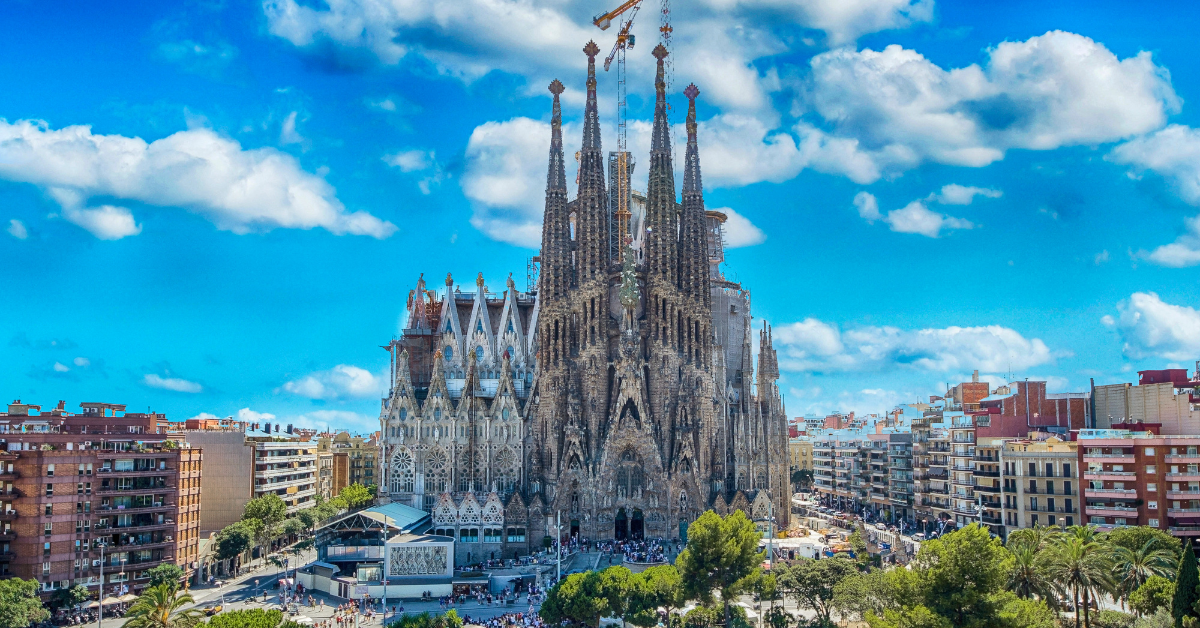The Sagrada Família, Antoni Gaudí’s unfinished masterpiece in Barcelona, fascinates people around the world. Yet Japanese visitors often interpret it differently from others. Their impressions reflect unique cultural values such as finding beauty in incompletion and appreciating meticulous details.
First Impressions of Japanese Visitors
When Japanese visitors first see the Sagrada Família, what leaves the strongest impression is the “beauty of being unfinished.” While many Western tourists focus on its historical value or the expectation of its eventual completion, Japanese people often feel that the basilica is “alive precisely because it is incomplete.” This idea comes from the Japanese aesthetic of finding beauty in imperfection.
Visitors often remark, “Even the cranes look like part of the scenery,” or “Its story feels ongoing precisely because it’s not finished.” Instead of viewing incompleteness as a flaw, Japanese people see value in the continuing process of growth.
| First Impressions of Japanese Visitors | Reason | Emotion |
|---|---|---|
| Beauty of incompletion | Resonates with the concept of wabi-sabi | Joy in witnessing growth |
| Construction as scenery | Emphasis on process and change | Sense of a living structure |
| Continuity over scale | Over 100 years of construction | Deep respect for time itself |
Japanese Religious Perspective and the Basilica’s Grandeur
Although most Japanese are not Christian, when they step inside the Sagrada Família, they sense “a profound spirituality that transcends religion.” This connects to Japanese religious traditions. In Japan, Shinto and Buddhism emphasize sacredness found in nature and human life.
Thus, Japanese visitors interpret the basilica’s towering spires and nature-inspired carvings as both symbols of faith and manifestations of harmony between humans and nature. For example, beams of light are described not only as “divine blessings” but also as “like sunlight filtering through a forest.”
| Japanese Religious View | Interpretation of Sagrada Família | Impressions |
|---|---|---|
| Shinto | Harmony with nature | Light and carvings seen as extensions of nature |
| Buddhism | Emphasis on spirituality | The entire basilica viewed as a symbol of meditation and devotion |
| Secular | Focus on creativity and human effort | Appreciation of artistic achievement beyond religion |
Japanese Aesthetic Sense and Appreciation for Details
Japanese visitors are particularly drawn not just to the basilica’s grandeur but also to its “meticulous details.” Japanese culture has long emphasized beauty in small, refined elements—such as the crackled glaze of tea bowls or the arrangement of stones in gardens.
In the Sagrada Família, this leads Japanese visitors to admire carvings, stained glass colors, and the shapes of pillars. Many compare the shifting hues of stained glass to seasonal transitions in Japan: cherry blossoms in spring, lush greens in summer, crimson leaves in autumn, and snowy landscapes in winter. For Japanese visitors, this sensitivity to change deepens their emotional connection.
| Japanese Aesthetic Value | What They Notice in Sagrada Família | Impressions |
|---|---|---|
| Focus on details | Color transitions of stained glass | Feels like the four seasons |
| Respect for stillness | Light filtering into the space | Sense of unity with nature |
| Admiration for craftsmanship | Carvings and pillars | Deep respect for artisans |
Comparing Sagrada Família with Japanese Architecture
When Japanese visitors see the Sagrada Família, they often compare it with their own architectural traditions. Japanese architecture traditionally uses wood and emphasizes harmony with the natural environment. In contrast, the Sagrada Família is made of stone and conveys a heavy, solemn atmosphere.
| Aspect | Traditional Japanese Architecture | Sagrada Família |
|---|---|---|
| Material | Wood | Stone |
| Aesthetic | Simplicity and open space | Density of ornamentation |
| Time Concept | Cycles of rebuilding | Continuous construction over 100 years |
| Impression | Tranquility and harmony | Grandeur and awe |
Japanese buildings often focus on renewal, while the Sagrada Família embodies “embracing incompletion while striving for completion.” This striking difference helps Japanese visitors reflect on contrasting concepts of time and deepens their sense of wonder.
Japanese Anticipation for the Future
Many Japanese visitors express the wish to return, saying, “I want to see it again when it’s completed.” In Japanese culture, there is an appreciation for processes rather than just final outcomes. Much like enjoying cherry blossoms from their budding to their falling, Japanese people value the journey toward completion.
Some recount, “Ten years ago, that part was under construction, but now it’s a beautiful tower,” highlighting joy not just in completion but in transformation itself. For Japanese visitors, the Sagrada Família is more than a building—it is a “living work of art.”
| Japanese Expectation | Reason | Emotion |
|---|---|---|
| Desire to witness completion | Cultural value on process | Joy in sharing growth |
| Wish to revisit | Each visit brings new changes | Surprise and anticipation |
| Appreciation of incompletion | Change itself holds meaning | Sense of a living structure |
Conclusion
The impressions Japanese visitors have of the Sagrada Família are deeply rooted in their cultural values and aesthetics.
- Admiration for the beauty of incompletion
- Appreciation of meticulous details
- Insights gained from comparing with Japanese architecture
- Joy in experiencing the process toward completion
For Japanese people, the Sagrada Família is not only a grand religious monument but also a mirror reflecting their cultural sensibility of cherishing the unfinished.






